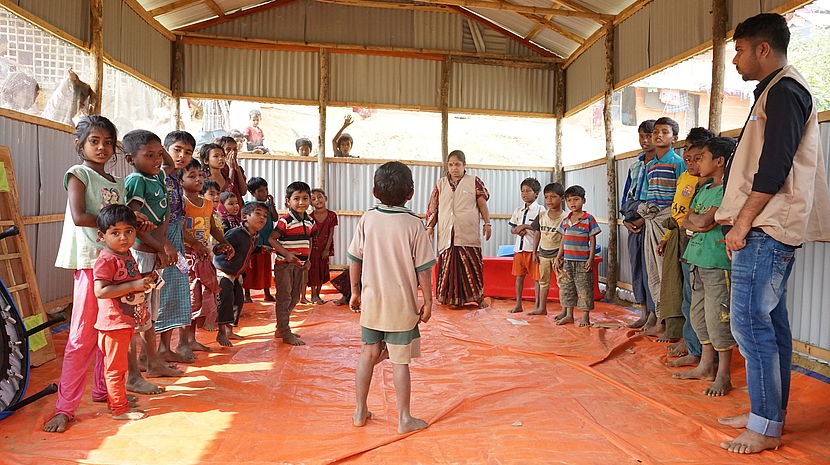Nepal Earthquake – Two Years On

Following the devastating earthquake of 25th April 2015, CBM, with partner organisations, has been working to ensure that everyone in the affected communities - including persons with disabilities - benefits from and participates in relief and recovery work. We have implemented emergency programmes in partnership with 9 local partners covering 17 districts affected by the earthquake.
Background information
On 25th April 2015 at 11:41 local time a 7.8 magnitude earthquake hit Nepal with the epicentre 81km northwest of Kathmandu. There were tremors of up to two minutes and by evening, at least 18 aftershocks had occurred. Just over two weeks later, on 12 May, a new earthquake measuring 7.3 magnitude struck 76 km northeast of Kathmandu, causing further damage.
Official figures report more than 8800 deaths, 22,000 people injured, 600,000 houses destroyed, and 285,000 houses
partially damaged.
Our work in Nepal
CBM has identified the following four key areas of interventions -
- Strengthening health services and increasing access to quality health and rehabilitation services
- Promote disability inclusive livelihood and education
- Increased accessibility and participation of persons with disability
- Enhance capacity and resilience of communities, partner organisations and government agencies on disability-inclusive disaster risk reduction (DiDRR).
Health and rehabilitation:Five projects reaching 2398 people so far are being implemented, specifically:
- 608 assistive devices distributed
- 181 corrective surgeries
- 179 female community health volunteers/workers received training on injury management and disability prevention
- 75 doctors/nurses trained on mental health and psychosocial support (MHPSS)
- 543 counselling sessions organised for 315 people with psychosocial disability
Livelihood and Education:
459 self-help groups and village livelihood improvement committees were formed so far where 420 earthquake survivors are already rehabilitated. 132 persons with disabilities have received training on how to start and improve your own business and are likely to start their venture soon.
Accessibility and inclusion:
CBM has been training DPOs (National Federation of the Disabled Nepal) and government authorities (Kathmandu Metropolitan City) to have a common understanding of accessibility and universal design and to contribute towards making the post-disaster construction phase more inclusive and accessible to everyone. 345 government engineers, architects, construction professionals and DPO representatives have been trained on accessibility and universal design principles. Partners have also undergone active follow-up and refresher plans.
Disability Inclusive Disaster Risk Reduction:
CBM is collaborating with the Ministry of Home Affairs through national networks to make sure that inclusion is prioritised in the upcoming National Disaster Risk Reduction Policy and Action Plan. Similarly, CBM is doing a comprehensive situation analysis on DiDRR to identify major stakeholders and actors and conducting research on the role CBM could play to promote DiDRR in Nepal.
CBM was also actively engaged in organising the Dhaka Conference on Disability & Disaster Risk Management in December 2015, Bangladesh and helped formulate an 8-point declaration and commitment. Other members (representing 18 countries) included national Governments, UNISDR, regional and international NGOs working on disability and disaster risk management, DPOs and others.
Rebuilding lives through inclusive livelihood
Sukra Bahadur Tamang, 30, lives in Gaurighar, Sidhupalchowk district with his three-year-old daughter and wife. As a two year old, Tamang lost four toes in an accident. His parents took him for check-up but all in vain. Recalling those dreadful days, Tamang says, “It took only 15 minutes for person without a disability to reach my school but for me it was more than two hours of difficult walk.” Unable to buy crutches, he then started walking by his hands and feet. “It was the toughest journey of my life,” Tamang adds.
After years of struggle, Tamang’s father bought him a pair of crutches. His mobility improved but he failed his tenth grade and decided to leave school. After a few years, Tamang lost his parents. The earthquake destroyed his house as well, leaving him and his family homeless.
An exemplary for all
Tamang’s life has seen some drastic improvements. He is a part of CBM’s disability inclusive livelihood programme implemented by CBM partner, SAPPROS Nepal. He underwent a week-long training on building nurseries and now grows thousands of saplings and produces vegetables. “I sell my vegetables within my community and earn about Rs.4500 a month,” he smiles.The road that leads to his house has also been made accessible for him. Tamang leads ‘Paurakhi Krishak Samuha’ - a self-help group providing training for the local community in agro-based organic farming and livelihood activities.
“I grow vegetables on land that I own, and this make me happy,” says Tamang. Since he started the nursery, he has been a source of inspiration for his community. “Thanks to CBM, I now live a dignified life and feel respected. Negative attitudes towards persons with disabilities are slowly changing,” he vouches.